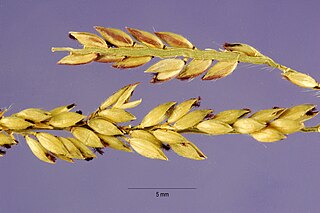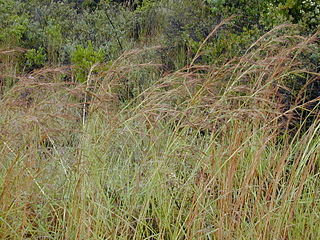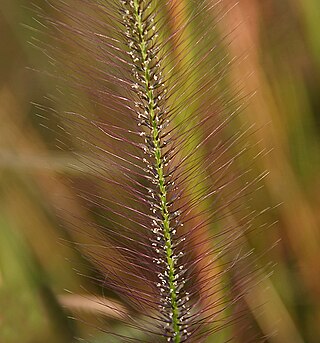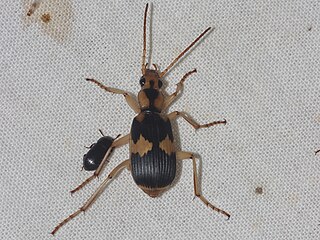
Quassia is a plant genus in the family Simaroubaceae. Its size is disputed; some botanists treat it as consisting of only one species, Quassia amara from tropical South America, while others treat it in a wide circumscription as a pantropical genus containing up to 40 species of trees and shrubs. The genus was named after a former slave from Suriname, Graman Quassi in the eighteenth century. He discovered the medicinal properties of the bark of Quassia amara.

Abrus is a genus of flowering plants in the pea family, Fabaceae, and the only genus in the tribe Abreae. It contains 13–18 species, but is best known for a single species: jequirity. The highly toxic seeds of that species are used to make jewellery.

Pennisetum is a widespread genus of plants in the grass family, native to tropical and warm temperate regions of the world. They are known commonly as fountaingrasses. Pennisetum is considered a synonym of Cenchrus in Kew's Plants of the World Online.

Zanthoxylum is a genus of about 250 species of deciduous and evergreen trees, shrubs and climbers in the family Rutaceae that are native to warm temperate and subtropical areas worldwide. It is the type genus of the tribe Zanthoxyleae in the subfamily Rutoideae. Several of the species have yellow heartwood, to which their generic name alludes. Several species are cultivated for their use as spices, notably including Sichuan pepper.

Najas, the water-nymphs or naiads, is a genus of aquatic plants. It is cosmopolitan in distribution, first described for modern science by Linnaeus in 1753. Until 1997, it was rarely placed in the Hydrocharitaceae, and was often taken as constituting the family Najadaceae.

Cyanotis is a genus of mainly perennial plants in the family Commelinaceae, first described in 1825. It is native to Africa, southern Asia, and northern Australia.

Dombeya is a flowering plant genus. Traditionally included in the family Sterculiaceae, it is included in the expanded Malvaceae in the APG and most subsequent systematics. These plants are known by a number of vernacular names which sometimes, misleadingly, allude to the superficial similarity of flowering Dombeya to pears or hydrangeas. Therefore, the genus as a whole is often simply called dombeyas. The generic name commemorates Joseph Dombey (1742–1794), a French botanist and explorer in South America, involved in the notorious "Dombey affair", embroiling scientists and governments of France, Spain, and Britain for more than two years.

Aneilema is a genus of monocotyledonous plants of approximately 60 species. The vast majority of the species are native to sub-Saharan Africa, but a few are found in Oceania and one, Aneilema brasiliense, is from South America. It is the third largest genus in the family Commelinaceae after Commelina and Tradescantia, and it is one of only six genera in the family to occur in both the Eastern Hemisphere and the Western Hemisphere.

Eriochloa is a widespread genus of plants in the grass family, commonly called cupgrass. They are found across much of Africa, Asia, Australia, and the Americas, plus a few places in European Russia.

Hyparrhenia is a genus of grasses. Many species are known commonly as thatching grass.

Perotis is a genus of Asian, African, and Australian plants in the grass family.

Hylodesmum is a genus of flowering plants in the family Fabaceae, sometimes called ticktrefoils or tick-trefoils. It is sometimes treated as part of Desmodium. It includes 16 species native to eastern North America, sub-Saharan Africa, Yemen, south, southeast, and eastern Asia, Malesia, and New Guinea.

Vanguerieae is a tribe of flowering plants in the family Rubiaceae and contains about 655 species in 30 genera. It is one of the most species-rich groups within the family and it is distributed across the Paleotropics.

The tribe Desmodieae is one of the subdivisions of the plant family Fabaceae. It is composed of two subtribes, Desmodiinae and Lespedezinae. Recent phylogenetics has this tribe nested within tribe Phaseoleae.

Murdannia is a genus of annual or perennial monocotyledonous flowering plants in the family Commelinaceae.

Pheropsophus is a genus of ground beetles in the family Carabidae.

Grona is a genus in the flowering plant family Fabaceae. Its native range is worldwide tropics and subtropics.
Indigofera arrecta, variously called the Bengal, Java, or Natal indigo, is a species of flowering plant in the family Fabaceae. It is native to Sub‑Saharan Africa, the Arabian Peninsula, and Madagascar, and has been introduced to the Indian Subcontinent, Southeast Asia, some of the islands of Indonesia, the Philippines, and Queensland in Australia.

Ophioglossum reticulatum, the netted adder's-tongue, is a species of fern in the family Ophioglossaceae. It has a pantropical/pansubtropical distribution; Latin America, the Caribbean, Sub-Saharan Africa, Madagascar, Yemen, the Indian Subcontinent, Southeast Asia, warmer parts of China, Malesia, Korea, Japan, and many tropical islands. A hexaploid, it has the highest number of chromosomes of any plant, 720. Its leaves—or leaf, individuals only grow one per year—are edible, and are regularly consumed by people in Africa and Asia.

Polhillides velutina is a species of flowering plant in the legume family, Fabaceae. It is the sole species in the genus Polhillides. It is an annual, perennial or sub-shrub, that is native to tropical regions of Africa and Madagascar, parts of Asia, New Guinea, and Australia. In Africa, its habitats include woodland and grassland in the Sudanian region, wooded grassland and grassland in the Victoria Basin forest–savanna mosaic, and wooded grassland and grassland in the Somalia-Masai region. It is found at elevations of up to 1,320 m (4,330 ft) above sea level.


















